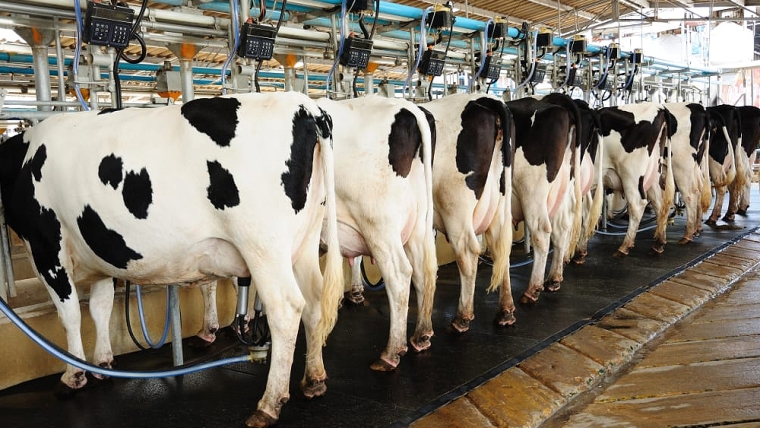
The Reserve Bank of New Zealand (RBNZ) says some dairy farmers will begin to default on their loans if commodity prices remain low for a long period of time.
Fonterra has set its milk price forecast at a midpoint of $7.25 per kilogram for the coming dairy season, down from $8.22 last year. This is higher than the lowest trough in 2015, adjusted for inflation, but farmers now face higher costs — including interest rates.
The central bank thinks low commodity prices and high operating costs in the primary sector could pose a threat to financial stability, if sustained across multiple seasons.
Kerry Watt, the RBNZ’s director of financial stability, said the agricultural sector made up 11% of all bank lending with the majority of those loans made out to dairy farmers.
“Whilst defaults in banks’ agricultural lending portfolios are currently low, they are expected to increase and could accelerate if there is a prolonged period of high costs and low prices,” he said.
This risk was outlined in a chapter of the Reserve Bank’s upcoming November financial stability report which was pre-released on Thursday.
China confidence crisis
The RBNZ noted agriculture demand from China—which typically buys a third of dairy, 40% of meat, and 60% of forestry exports—had been declining with consumer confidence as the economy has emerged from Covid restrictions.
This has put pressure on dairy farmers, who have been showing some early signs of rising financial stress, and could threaten the wider economy.
New Zealand is more reliant on the agriculture sector than most other advanced economies.
Few farmers have defaulted so far, but demand for working capital had “surged” as farmers reached for credit facilities to support cashflow.
“Defaults, payments overdue by more than 90 days, could increase materially if there is a prolonged downturn in export prices and demand,” Watt said.
“Banks tell us they are monitoring the situation and working closely with their rural customers.”
Farm input costs have increased significantly over the past couple of years, with animal feed and fuel prices rising after the invasion of Ukraine. Meanwhile, local inflation has boosted the prices of labour, electricity and insurance.
The rapid increase of interest rates has also boosted debt servicing costs for farmers, who now faced an estimated cost per kilogram of $1.43 in August — up from just 59 cents two years ago.
The RBNZ said dairy farmers had “generally deleveraged” over the past five years but those who are still carrying significant amounts of debt would be seriously impacted.
Profitability pressured
Fonterra’s reduced farmgate milk forecast could leave many farmers struggling to cover their costs this season. The average breakeven price is estimated to be around $8 per kilogram, or 75 cents more than current expected.
Analysis provided to the central bank by Figured estimated that half of all dairy farms would make a loss if the final milk price were to settle at $6.75 and over 60% if it dropped to $6.25.
“How long farmers can operate under these conditions depends on factors such as indebtedness, access to working capital, cost structures and scale,” the RBNZ said.
Retail banks told the RBNZ they expect defaults among dairy borrowers to rise over the coming year, because there tends to be a time lag between cashflow stress and default.
“A prolonged period of low dairy prices or a further reduction in prices are more likely to exhaust the cash buffer of farmers with weaker balance sheets, leading to materially higher default rates”.
An added challenge for dairy farms is the prospect of being charged for carbon and methane emissions sometime after 2025, under the incoming National Government.
The Reserve Bank asked retail banks to estimate the impacts of a range of emission prices and has focused on a starting price of $15 per tonne. At that level, 8% of dairy borrowers would be unprofitable compared to 6% without emissions pricing.
This estimate assumed international milk prices were kept at a fixed level and did not rise as agricultural emissions prices were also put in place overseas.
27 Comments
This is a free report right!
someone must have thrown the last door stop out as this one seems to be just a restatement of the obvious
"NZ is more reliant on the agriculture sector than most other advanced economies" FFS
“Whilst defaults in banks’ agricultural lending portfolios are currently low, they are expected to increase and could accelerate if there is a prolonged period of high costs and low prices,”
Having a low level of defaults over an extended period should be concerning, it means banks are being too risk averse in lending behaviour. The optimum scenario is for banks to manage risk through business cycles.
Hilarious. The RBNZ and the rest of the central banks suffered from group think, causing inflation "transitory" and then acting too late, forcing interests rates to go higher for longer. As a result, as dairy farm debt has rolled over, it has meant the cost to service that debt is much greater. The RBNZ then come out and say its hard for the farmers to pay their loans and the fault is because they aren't getting enough money for their product.
You couldn't make this up if you tried, the RBNZ marking its own homework saying its done a great job of responding to inflation, then laying the blame of financial instability somewhere else when it was clearly them screwing everyone from the start.
Farm prices are too high. Over a decade of stupidly low interest rates caused land prices to inflate to insane levels. The level of debt required to own a farm today is the major issue, interest rates aren't even high.
I think part of it was Farmers got gold fever..."white gold"... NZ was going to take over the world..!!!
AND...the over leveraged ones have been hanging in there for over a decade trying to keep heads above water..... has been a very slow train wreck.
https://www.rnz.co.nz/news/on-the-inside/299064/the-end-of-the-white-go…
Agree... and who caused low interest rates again? OH! The central banks all playing follow the leader, who just happened to be the Fed playing Pied Piper
This may well collide with an increase in Home Mortgage defaults next year. This is a recipe for a perfect financial storm.
And subsequent plummet of the OCR
I don’t think the OCR is going to plummet.
That ship as sailed.
With NZD at .57 and Inflation still raging........ the OCR needs to be hiked big!
Exactly. Speculative gambling via leverage is about to get punished for the first time in ages.
Just a dream.
Regardless of this report we have too much capital tied up in the dairy industry.
Explanation required on your “ too much capital tied up in dairy industry “ ?
by Audaxes | 19th Nov 19, 10:32am
For all of the above reasons, 3.09% is the correct value of dairy’s contribution to the New Zealand economy. Link - https://www.interest.co.nz/rural-news/102177/nzier-takes-issue-keith-woodfords-view-gdp-understates-economic-contribution
As a non-economist can I conclude that bank lending to the agricultural sector is underwriting land banking rather than productive enterprise that qualifies for inclusion in the GDP calculation algorithm?
Westpac NZ CEO:
Some heavily indebted dairy farmers are barely covering their interest payments despite relatively strong prices for several seasons, Westpac NZ chief executive David McLean says.
"The ones who've got more leverage, most of those are still covering their cost of production but some of them are close to the edge," he says.
"Their interest cover isn't that great – there are a lot of farmers who are doing it tough and there's not a lot of buffer." Link - https://www.nzherald.co.nz/the-country/news/article.cfm?c_id=16&objectid=12282488
You could conclude that. But you could ask how much of the economy would continue to exist if dairy was no longer there and you'd probably conclude that the GDP figure was complete bollocks. For instance as a contract milker I'm included in the service industries, perfectly logical to an economist I'm sure.
I'm no economist. My understanding of gdp is that it's internal and uses arbitrary classifications of contributors.
But the money supply cycling around the economy is derived from export earnings and that is where primary production makes a much higher than 3.09% contribution.
I liken the nz economy to a household economy - income exceeds expenses everyone is happy, expenses exceed income.....roll on misery.
Wrong. Just borrow more. Been working the last 50 years.
Please tell us an alternative investment
But the banks didn't want low debt farmers before , they set up telephone only services and bullied them when ever there was a drought or financial crisis, ASB even had a farm line solutions department
Wonder how many farmer suicides are caused by the unfair treatment that the banks used against farmers with little debt on family farms
and does the coroner look into it
You guys need to take a chill pill. Providing reports from four to seven years out of date using obsolete payout numbers.
Apart from the comments on Climate related risks the Reserve Bank financial stability report is laughable. Saying if income goes down or costs go up some farmers will make less money -Duh. You could say the same for any industry in NZ.
We analysed Northland dairy farm sales over the past fifteen years. Using farms where dairy was the best land use prices had not changed in fifteen years per kg ms produced. Any price increase was largely due to production (income) improvement.
Is that because dairy like wheat is a basic commodity.
People will never pay a premium for bread and milk.
No one is forced to borrow money and it's up to every business to assess the risks,along with lenders. Every business is the same and those that have lower debt and good risk assessment will be fine. The bottom 10 to 20% always struggle and some will fail. Part of the business cycle of life I'm afraid.
On average interest rates are not high at the moment.
Very nice to ,have a very conservative approach. If you can get it. Does' not happen in the real world unfortunately
Might have to have another look at Rabobanks financials
They are very exposed to dairy and their deposit rates have been above the Aussie rates for a while now
They have huge overseas backing but if the worst happens would they help?
In the real world it does happen as only those that plan to real risk and reality will survive in the end. Having been in business for over 40 years I can attest to that.
Imagine if there was a global recession and demand for oil was down heaps, and Saudi Arabia decided to pump up volumes by 20% as it was suffering from declining revenue and working capital. How would that country be labelled with such a ridiculous strategy.
And yet here in NZ the dairy industry has doing something analogous for years, increasing production (with the markedly increased costs of system 5 farms) into reduced demand with a corresponding loss of net income and working capital.
When you supply 75% of the world trade in WMP you should reduce supply, reduce costs by moving to a different farming system, and maximise profits and working capital when demand is weak.
Not carry on BAU or try and increase production. The industry here is run by fools who are more interested than increasing production than profits as that is what land values are primarily based on.
Hence over priced land and broke farmers.

We welcome your comments below. If you are not already registered, please register to comment
Remember we welcome robust, respectful and insightful debate. We don't welcome abusive or defamatory comments and will de-register those repeatedly making such comments. Our current comment policy is here.